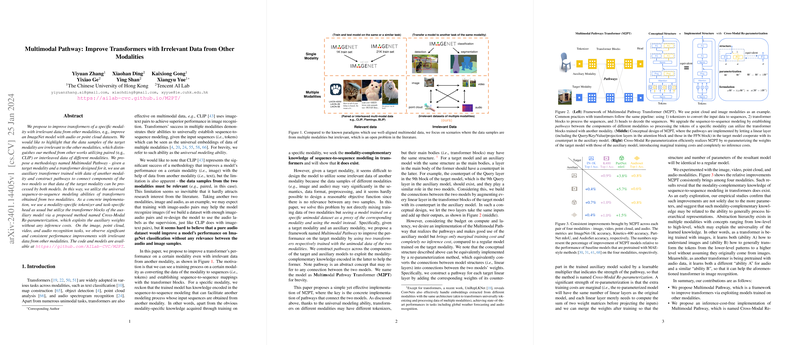Introduction
Transformers have demonstrated their prowess across a variety of tasks and modalities, illustrated by their universal modeling capabilities for sequence-to-sequence learning. However, contemporary methods often rely on the use of relevant multimodal data, such as paired datasets. In "Multimodal Pathway: Improve Transformers with Irrelevant Data from Other Modalities," authors propose an unconventional approach leveraging data from different modalities that are not explicitly related.
Leveraging Irrelevant Data
The work is grounded in the ability of transformers to universalize embedding data across modalities, allowing them to process information from images or audio as sequences of tokens. It breaks new ground by suggesting that data irrelevance, often a limitation in conventional models, can be harnessed to improve transformer performance. The authors' method dissociates from the norm of using well-aligned paired data (e.g., image-text pairs) and explores the untapped potential of unrelated datasets.
Multimodal Pathways Transformer (M2PT)
The core of the approach lies in constructing pathways that allow data from the auxiliary modality to be processed alongside data from the target modality within transformers. Crucially, a technique named Cross-Modal Re-parameterization is introduced, which integrates weights from an auxiliary model trained on a different modality into the target transformers without incurring inference costs. The model, M2PT, is designed to access universal sequence-to-sequence modeling abilities by forming a network that connects components of the different modality-specific transformers.
Experimental Results and Observations
Considerable advancements were made by M2PT over multiple modalities on a variety of tasks, including image, point cloud, video, and audio recognition. One key insight is that the performance enhancements observed are not purely due to the increase in parameters. The results suggest that the modality-complementary knowledge gained from training on disparate datasets may relate to the transformer's ability to process hierarchical representations—a universal feature prominent across different modalities.
Conclusion and Future Directions
Despite the empirical successes, the research uncovers a field with ample room for theoretical exploration. The precise mechanisms behind the performance boosts an area ripe for deeper investigation, potentially requiring a more profound understanding of neural network internals. The "Multimodal Pathway" approach encourages a reimagination of how unrelated data can cross-pollinate and enrich models designed for specific modalities, marking a promising avenue for future research.
